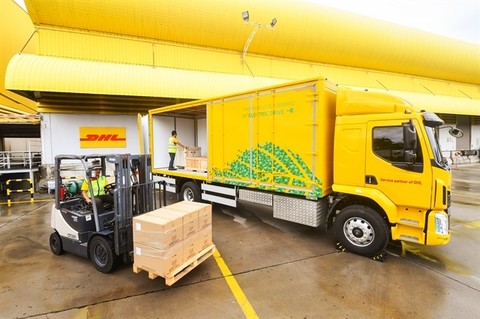
Stafts of DHL at work. Road transport of goods continues to play a critical and increased role in Southeast Asia including Việt Nam. — Photo Courtesy of DHL Global Forwarding
Road transport of goods will continue to play a critical and increasing role in Southeast Asia, including Việt Nam, as companies look to build more resilient supply chains, experts have said.
A report by International Data Corporation expects 45 per cent of Asian organisations to operationalise integrated sustainability in the supply chain by 2026.
Meanwhile, as global companies diversify their supply chains, Chinese firms are also increasing their manufacturing presence in the region.
In 2023 China’s investment in Southeast Asia reached US$24 billion, according to a report by McKinsey.
It highlights the region's growing importance as a global manufacturing hub, especially countries such as Việt Nam, Cambodia, Laos, and Thailand, which have announced or implemented improvements to or expansion of transportation infrastructure that are vital for logistics.
A new white paper titled “Highway to the Future: Navigating the Road Freight Opportunities in Southeast Asia”, released by Germany's express delivery company DHL Global Forwarding, explores the importance of road freight in Việt Nam and other markets in the region.
It emphasises that goods will always need to be transported by road at some point - even if it is just a short distance from the airport or seaport and from the delivery person to the recipient.
Even as air and sea freight return to normal, the demand for road transport persists, it says.
Road transport remains the most feasible door-to-door transportation solution for markets with strong land connectivity networks like Southeast Asia, it says.
In Việt Nam, the Government is aiming to complete 3,000km of highways by 2025.
“There has been a shift in global supply chain in the last few years, and Việt Nam is certainly leading the pack in Southeast Asia,” the report says.
Last year foreign direct investment in Việt Nam was worth US$16 billion and its exports topped $440 billion, making it the largest exporting nation in Southeast Asia.
Laurence Cheung, country manager, Vietnam, DHL Global Forwarding, said: “Roads also link China with Southeast Asia, with Việt Nam being in the centre of it. With supply chain diversification and Chinese companies going global, Việt Nam is strategically located to take advantage of these opportunities.”
According to IHS Markit and UN Comtrade, Việt Nam is emerging as the clear winner as manufacturing supply chains shift, with sharp increases in its exports of manufacturing, technology, fashion, and retail goods.
Countries such as Thailand, Malaysia and Singapore are also set to benefit, especially with their connectivity options and trade agreements with major global economies.
Laos opened a new rail link between Vientiane and China’s Kunming in 2021.
In Thailand, DHL has opened the new DHL International Multimodal Hub in Suvarnabhumi Airport Free Zone 3, making it easier for shipments to move in, out and through Thailand across different transportation modes.
“These investments into making rail and road infrastructure better in Southeast Asia means that it is cheaper and faster to ship from China to Southeast Asia,” Bruno Selmoni, VP, head of road freight and multimodal solutions, Southeast Asia, DHL Global Forwarding, said.
“Road freight plays an important role in a standalone as well as a multimodal solution. Moving goods through a combination of transport modes can result in faster door-to-door lead time compared to ocean freight, with substantially lower costs than air freight.”
Government policies help streamline cross-border freight
Government initiatives in the region have helped streamline shipments across borders.
Countries in the region are also attempting to resolve border issues, collaborate on improving infrastructure, and streamline procedures.

Road transport remains the most feasible door-to-door transportation solution for many markets. — Photo courtesy of binhduonglogistics.com
Initiatives like ASEAN’s Customs Transit System aim to streamline the processes and reduce paperwork further.
Customs agencies of all 10 ASEAN member states endorsed the ASEAN Authorised Economic Operator Mutual Recognition Arrangement in 2023 to establish a consistent and transparent trading environment.
It aligns certification standards with the World Customs Organisation SAFE Framework, ensuring expedited cargo clearance and priority treatment for certified authorised economic operators within the region.
Countries in the region have also taken steps independently to facilitate cross-border movement of goods. Cambodia and Việt Nam, for example, have worked together to add lanes to a congested checkpoint.
A push towards a more sustainable road freight is needed but significant challenges remain.
The ASEAN Regional Strategy for Sustainable Land Transport highlighted three categories of green freight policies and measures including logistics optimisation, such as reducing empty hauling and implementing logistics centres and freight exchanges.
Another measure it envisages is the use of multimodal transport including rail and waterways. — VNS